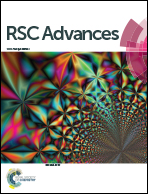Induced application of biological waste Escherichia coli functionalized with an amine-based polymer for CO2 capture†
Abstract
Carbon dioxide adsorption by solid sorbents is a promising technology to mitigate the greenhouse effect. To utilize biological waste as an alternative solid sorbent for CO2 capture, the surface of the biological waste Escherichia coli was modified through polymerization of poly(allylamine hydrochloride) with a crosslinking agent (epicholorohydrine). We found that the surface-modified PEI/E. coli showed good CO2 adsorption performance in terms of capacity (1.8 wt%) and amine efficiency (0.93 mmol CO2 per mmol N) compared with that of pristine E. coli (0.7 wt%). Furthermore, the heat of CO2 adsorption (71.67 kJ mol−1) supports the moderate interaction between CO2 and PEI/E. coli for favorable CO2 adsorption and desorption. Density functional theory calculations were carried out to investigate the PEI activity comprehensively in terms of structural deformation and binding energetics between CO2 and the PEI polymer with molecular adsorption mechanisms. This approach could open up the possibility of surface modification of biological waste and new pathways to reuse biological waste as an alternative source to reduce the concentration of various greenhouse gases, thereby conserving the environmental balance.


 Please wait while we load your content...
Please wait while we load your content...